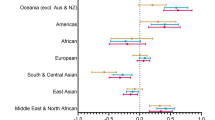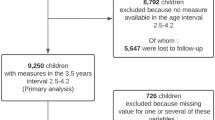Abstract
Objective
To determine the extent to which ethnic differences in BMI Z-scores and obesity rates could be explained by the differential distribution of demographic (e.g. age), familial (e.g. family income), area (e.g. area deprivation), parental (e.g. immigration status), and birth (e.g. gestational age) characteristics across ethnic groups.
Methods
We used data on 4-year-old children born in New Zealand who attended the B4 School Check between the fiscal years of 2010/2011 to 2015/2016, who were resident in the country when the 2013 census was completed (n = 253,260). We implemented an Oaxaca–Blinder decomposition to explain differences in BMI Z-score and obesity between Māori (n = 63,061) and European (n = 139,546) children, and Pacific (n = 21,527) and European children.
Results
Overall, 15.2% of the children were obese and mean BMI Z-score was 0.66 (SD = 1.04). The Oaxaca–Blinder decomposition demonstrated that the difference in obesity rates between Māori and European children would halve if Māori children experienced the same familial and area level conditions as Europeans. If Pacific children had the same characteristics as European children, differences in obesity rates would reduce by approximately one third, but differences in mean BMI Z-scores would only reduce by 16.1%.
Conclusion
The differential distribution of familial, parental, area, and birth characteristics across ethnic groups explain a substantial percentage of the ethnic differences in obesity, especially for Māori compared to European children. However, marked disparities remain.
This is a preview of subscription content, access via your institution
Access options
Subscribe to this journal
Receive 12 print issues and online access
$259.00 per year
only $21.58 per issue
Buy this article
- Purchase on Springer Link
- Instant access to full article PDF
Prices may be subject to local taxes which are calculated during checkout

Similar content being viewed by others
References
Pan L, Grummer-Strawn LM, McGuire LC, Park S, Blanck HM. Trends in state/territorial obesity prevalence by race/ethnicity among U.S. low-income, preschool-aged children. Pediatr Obes. 2016;11:397–402.
Bygdell M, Ohlsson C, Célind J, Saternus J, Sondén A, Kindblom JM. The rise and the recent decline of childhood obesity in Swedish boys: the BEST cohort. Int J Obes. 2017;41:807–12.
Ogden CL, Carroll MD, Lawman HG, Fryar CD, Kruszon-Moran D, Kit BK. et al. Trends in obesity prevalence among children and adolescents in the United States, 1988–1994 through 2013–2014. JAMA. 2016;315:2292–9.
Shackleton N, Milne BJ, Audas R, Derraik JGB, Zhu T, Taylor RW. et al. Improving rates of overweight, obesity and extreme obesity in New Zealand 4-year-old children in 2010-2016. Pediatr Obes. 2017;13:766–77.
Salmond CE, Crampton P. Development of New Zealand’s deprivation index (NZDep) and its uptake as a national policy tool. Can J Public Health/Revue Canadienne de Sante’e Publique. 2012;S7–S11.
Rossen LM, Talih M. Social determinants of disparities in weight among US children and adolescents. Ann Epidemiol. 2014;24:705–13. e702
Rossen LM. Neighbourhood economic deprivation explains racial/ethnic disparities in overweight and obesity among children and adolescents in the USA. J Epidemiol Commun Health. 2014;68:123–9.
Zilanawala A, Davis-Kean P, Nazroo J, Sacker A, Simonton S, Kelly Y. Race/Ethnic disparities in early childhood BMI, obesity and overweight in the United Kingdom and United States. Int J Obes. 2015;39:520–9.
Reid P, Robson B. Understanding health inequities. Hauora: Māori Standards of Health IV A study of the years. 2000;2005:3–10.
Jones CP. Levels of racism: a theoretic framework and a gardener’s tale. Am J Public Health. 2000;90:1212–5.
Sadler L, Priest P, Peters J, Crengle S, Jackson R. Cervical cancer audit report: screening of women with cervical cancer, 2000–2002. Wellington: Ministry of Health; 2004.
Ministry of Health Report on maternity: maternal and newborn information 2003. Wellington: Ministry of Health; 2006.
Davis P, Lay-Yee R, Dyall L, Briant R, Sporle A, Brunt D. et al. Quality of hospital care for Māori patients in New Zealand: retrospective cross-sectional assessment. Lancet. 2006;367:1920–5.
Jeffreys M, Stevanovic V, Tobias M, Lewis C, Ellison-Loschmann L, Pearce N. et al. Ethnic inequalities in cancer survival in New Zealand: linkage study. Am J Public Health. 2005;95:834–7.
Lee CH, Duck IM, Sibley CG. Ethnic inequality in diagnosis with depression and anxiety disorders. N Z Med J. 2017;130:10.
Pledger MJ, Cumming J, Burnette M, Daubé J. Unmet need of GP services in Pacific people and other New Zealanders. N Z Med J. 2011;124:35–45.
Statistics New Zealand. 2013 Census QuickStats about culture and identity. Vol. 2018, www.stats.govt.nz. Wellington, New Zealand: Statistics New Zealand; 2014.
Brown C, Lao C, Lawrenson R, Tin TS, Schaaf M, Kidd, J. et al. Characteristics of and differences between Pasifika women and New Zealand European women diagnosed with breast cancer in New Zealand. New Zealand Medical Journal. 2017;130:50–61.
Maoate K, Frizelle F. Equity, education and health outcomes in Pacific peoples in New Zealand. N Z Med J. 2013;126:6–8.
Westerman T. Guest editorial: engagement of Indigenous clients in mental health services: what role do cultural differences play? Aust J Adv Ment Health. 2004;3:88–93.
Anderson LM, Scrimshaw SC, Fullilove MT, Fielding JE, Normand J. Culturally competent healthcare systems: a systematic review. Am J Prev Med. 2003;24:68–79.
Pulotu-Endemann FK, Faleafa M. Developing a culturally competent workforce that meets the needs of Pacific people living in New Zealand. In: Workforce development theory and practice in the mental health sector. 2016;165–180.
Carroll-Scott A, Gilstad-Hayden K, Rosenthal L, Peters SM, McCaslin C, Joyce R. et al. Disentangling neighborhood contextual associations with child body mass index, diet, and physical activity: the role of built, socioeconomic, and social environments. Soc Sci Med. 2013;95:106–14.
Oliver LN, Hayes MV. Effects of neighbourhood income on reported body mass index: an eight year longitudinal study of Canadian children. BMC Public Health. 2008;8:16.
Janssen I, Boyce WF, Simpson K, Pickett W. Influence of individual-and area-level measures of socioeconomic status on obesity, unhealthy eating, and physical inactivity in Canadian adolescents. Am J Clin Nutr. 2006;83:139–45.
Li X, Memarian E, Sundquist J, Zöller B, Sundquist K. Neighbourhood deprivation, individual-level familial and socio-demographic factors and diagnosed childhood obesity: a nationwide multilevel study from Sweden. Obes Facts. 2014;7:253–63.
Schüle SA, Kries R, Fromme H, Bolte G. Neighbourhood socioeconomic context, individual socioeconomic position, and overweight in young children: a multilevel study in a large German city. BMC Obes. 2016;3:25.
Garfinkel-Castro A, Kim K, Hamidi S, Ewing R. Obesity and the built environment at different urban scales: examining the literature. Nutr Rev. 2017;75:51–61.
NHS Digital. National child measurement programme, England 2015 to 2016 school year. NationalStatistics, Gov.uk; 2016.
Aarestrup J, Bjerregaard LG, Gamborg M, Angquist L, Tjonneland A, Overvad K. et al. Tracking of body mass index from 7 to 69 years of age. Int J Obes. 2016;40:1376–83.
Evensen E, Wilsgaard T, Furberg A-S, Skeie G. Tracking of overweight and obesity from early childhood to adolescence in a population-based cohort—the Tromsø study, fit futures. BMC Pediatrics. 2016;16:64–64.
Ministry of Health The B4 school check: a handbook for practitioners. Wellington: Ministry of Health; 2008.
Blinder A. Wage discrimination: reduced form and structural estimates. J Hum Resour. 1973;8:436–55.
Oaxaca R. Male–female wage differentials in urban labor markets. Int Econ Rev. 1973; 14:693–709.
Jann B. The Blinder–Oaxaca decomposition for linear regression models. Stata J. 2008;8:453–79.
Sen B. Using the Oaxaca–Blinder decomposition as an empirical tool to analyze racial disparities in obesity. Obesity. 2014;22:1750–5.
Powell LM, Wada R, Krauss RC, Wang Y. Ethnic disparities in adolescent body mass index in the United States: the role of parental socioeconomic status and economic contextual factors. Social Sci Med. 2012;75:469–76.
Sen B, Mennemeyer S, Gary LC. The relationship between perceptions of neighborhood characteristics and obesity among children. In: Grossman M, Mocan HN, (eds.), Economic aspects of obesity. The University of Chicago Press University of Chicago Press; 2011. pp. 145–80.
Singleton CR, Affuso O, Sen B. Decomposing racial disparities in obesity prevalence: variations in retail food environment. Am J Prev Med. 2016;50:365–72.
Ministry of Health. Enrolment in a primary health organisation. New Zealand Government; 2017, https://www.health.govt.nz/our-work/primary-health-care/about-primary-healthorganisations/enrolment-primary-health-organisation.
Statistics New Zealand Coverage in the 2013 Census based on the New Zealand 2013 post-enumeration survey. Wellington: Statistics New Zealand; 2014.
WHO. Child growth standards: WHO Anthro (version 3.2.2, January 2011) and macros. Vol. 2016. WHO; Geneva: WHO; 2016.
Reid G, Bycroft C, Gleisner F. Comparison of ethnicity information in administrative data and the census. Wellington, New Zealand: Statistics New Zealand Tatauranga Aotearoa; 2016.
Ministry of Health. Ethnicity data protocols for the health and disability sector. Wellington: Ministry of Health; 2004.
Milne BJ, Atkinson J, Blakely T, Day H, Douwes J, Gibb S. et al. Data Resource Profile: The New Zealand Integrated Data Infrastructure (IDI). International Journal of Epidemiology. 2019.
Exeter DJ, Zhao J, Crengle S, Lee A, Browne M. The New Zealand indices of multiple deprivation (IMD): a new suite of indicators for social and health research in Aotearoa, New Zealand. PLoS ONE. 2017;12:e0181260.
Guyer B, Hoyert DL, Martin JA, Ventura SJ, MacDorman MF, Strobino DM. Annual summary of vital statistics—1998. Pediatrics. 1999;104:1229–46.
StataCorp. Stata statistical software: release 14. College Station, TX, USA: StataCorp LP; 2015.
Yun MS. A simple solution to the identification problem in detailed wage decompositions. Econ Inq. 2005;43:766–72.
Lee H, Lee S, Park E. Do family meals affect childhood overweight or obesity?: nationwide survey 2008–2012. Pediatr Obes. 2016;11:161–5.
Jago R, Baranowski T, Baranowski JC, Thompson D, Greaves K. BMI from 3–6 y of age is predicted by TV viewing and physical activity, not diet. Int J Obes. 2005;29:557.
Maffeis C, Talamini G, Tato L. Influence of diet, physical activity and parents’ obesity on children’s adiposity: a four-year longitudinal study. Int J Obes. 1998;22:758.
Stryjecki C, Alyass A, Meyre D. Ethnic and population differences in the genetic predisposition to human obesity. Obes Rev. 2018;19:62–80.
Duncan JS, Duncan EK, Schofield G. Ethnic-specific body mass index cut-off points for overweight and obesity in girls. N Z Med J. 2010;123:22–29.
Tyrrell V, Richards G, Hofman P, Gillies G, Robinson E, Cutfield W. Obesity in Auckland school children: a comparison of the body mass index and percentage body fat as the diagnostic criterion. Int J Obes. 2001;25:164.
Tiatia-Seath S. Pacific cultural competencies: a literature review. New Zealand Ministry of Health; 2008.
Wilson D. The significance of a culturally appropriate health service for Indigenous Māori women. Contemp Nurse. 2008;28:173–88.
Gibb S, Milne B, Shackleton N, Taylor BJ, Audas R. How universal are universal preschool health checks? An observational study using routine data from New Zealand’s B4 School Check. BMJ Open 2019;9:e025535.
Acknowledgements
We wish to thank Statistics New Zealand for access to these data, and to the Data Lab staff for their speedy and thorough checking of our results. We also note that Dr. Glover was employed at Massey University at the time of the study. This work was conducted for A Better Start National Science Challenge, which is supported by the Ministry of Business, Innovation, and Employment. The funding agency had no role in the design and conduct of the study, management, analyses, interpretation of the results or in the preparation, review or approval of the manuscript.
Author information
Authors and Affiliations
Corresponding author
Ethics declarations
Conflict of interest
The authors declare that they have no conflict of interest.
Additional information
Publisher’s note: Springer Nature remains neutral with regard to jurisdictional claims in published maps and institutional affiliations.
Supplementary information
41366_2019_390_MOESM1_ESM.docx
Supplementary table 1. The univariate distribution of the covariates in the sample, and the bivariate distribution between for each covariate with BMI z-score and Obesity
Rights and permissions
About this article
Cite this article
Shackleton, N., Derraik, J.G.B., Audas, R. et al. Decomposing ethnic differences in body mass index and obesity rates among New Zealand pre-schoolers. Int J Obes 43, 1951–1960 (2019). https://doi.org/10.1038/s41366-019-0390-4
Received:
Revised:
Accepted:
Published:
Issue Date:
DOI: https://doi.org/10.1038/s41366-019-0390-4



